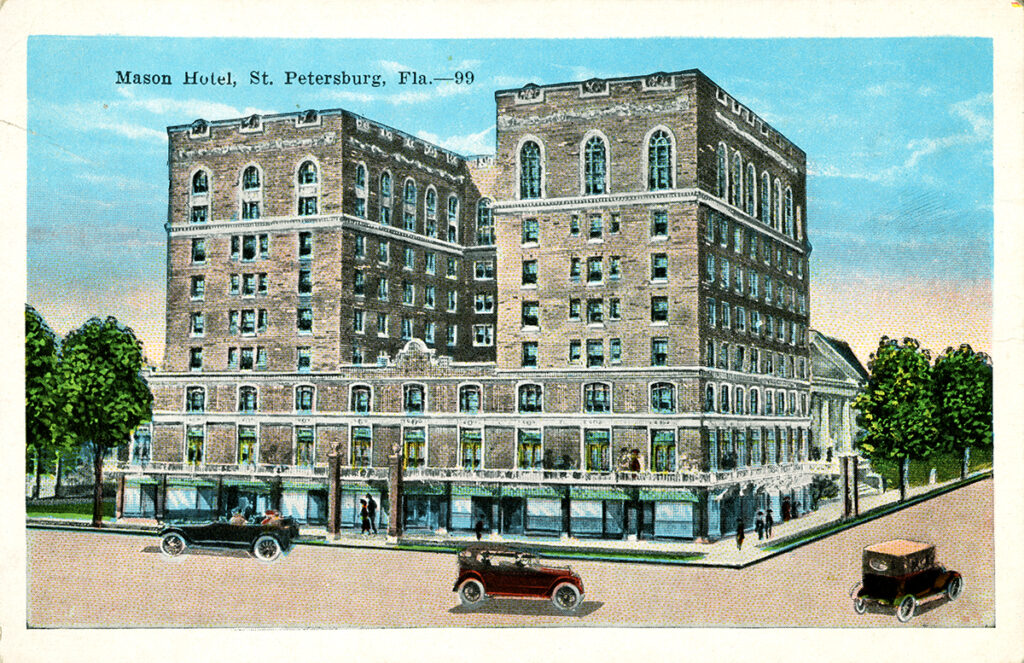In 1995, the St. Petersburg City Council designated the Princess Martha as a historic landmark. Operating as a hotel for nearly 65 years, and then as a home for retirees, the stately Neoclassical red-brick building stands as a reminder of the city’s first big boom. It was one of 10 hotels constructed between 1923 and 1926. Its builders promised “features that are scarcely rivaled” that will “add immediately to the prestige which the city’s new great tourist hotels are bringing to St. Petersburg.” Opened with much fanfare on January 4, 1924, the Hotel Mason, as it was originally called, lived up to the promise.
“Announcing Hotel Mason”
Just days before the grand opening, any question a potential guest or curious local might have had about the prestigious new property was answered in a special “Hotel Mason Section” of the Sunday St. Petersburg Times. Stories offered details about everything from the hotel’s builders, architects, and design teams to its unmarred construction safety record, “master key” safety system, and the career path of the highly sought-after manager who had started as a bellhop. Advertisers filled the pages to claim their status as providers of hotel furnishings, linens, draperies, and carpets. Others announced available services on the hotel grounds, including a flower shop and five-chair barber shop. An artist’s rendering of the lobby’s chandelier served as the pictorial lead to the 15-page advertorial section. According to the Times, the light fixture was a perfect symbol for another “venture of service and fortune — the Mason Hotel.” Like the chandelier’s inspiration, the 15th-century Oró del Sol, the Hotel Mason “sails into St. Petersburg laden like a galleon from the Indies with wealth and riches.”
“Quiet luxury prevails”
As the Times noted, “whatever money could do to add to the attractiveness of the Mason has been done.” Inside the Neoclassical façade, three periods were combined to great effect, and at an estimated cost of more than $1.5 million, “an air of quiet luxury prevails.” Visitors and guests entered an Italian Renaissance “lobby warm with Spanish colorings, and tiling, and rich in luxury.” Guests could ascend the grand staircase to enjoy the view from the colonial-style mezzanine lounge as they admired the bas relief frescoes and the wide, arched windows hung with heavy gold and black curtains. The dining room served world-class food surrounded by the high ceilings and massive columns of the Neoclassical Adams Period. As an added luxury, guests could access the elevator to their rooms through a private passage, allowing them to avoid the public lobby and the lounge. Inch-thick plush velvet carpet blanketed the floors of the hallways as well as the 250 guest rooms, which featured “enduring all-steel furniture…with a finish that is hardly distinguishable from wood” and comfortable beds covered in “snowy white” bedspreads embossed with the Mason Hotel logo which, as the Times noted, invited guests to “stop and rest.” Each room included a private bath, then uncommon. The hotel’s advertisements boasted: “250 Rooms-250 Baths.” Clearly, no expense had been spared.

Quiet Vacuums, Warm Baths, and Ice Cold Water!
As the numerous advertisements and stories asserted, each element of the hotel’s infrastructure was the best of its time. The electrical system was “the biggest … ever done in St. Petersburg” and “one of the finest.” The much-vaunted “odorless incinerator” meant “no garbage wagons or piggery trucks” would be necessary to haul away waste. The excess heat generated fueled the hotel’s steam heat and hot water for guests wanting a warm soak in their private bath. Conversely, the hotel also boasted “one of the best refrigeration systems in the South.” Buried in the basement, this multifaceted operation supplied block ice for the hotel’s “ideally appointed” kitchen and its numerous ice boxes as well as cubed ice for the dining tables. The cooling system also chilled the circulating ice water available from several outlets on each guest floor. Pumped through insulated pipes and supplied by the hotel’s private “soft water system,” this feature eliminated the potentially annoying wait for a bellboy to deliver a cool drink. Also contributing to the comfort of a guest’s hotel stay was the vacuum system. With the suction pump and waste receptacles in the basement and five hose outlets on every floor, cleaning the furnishings and fixtures using the 56-foot attached hoses was “practically noiseless” and “dustless.” Like the architecture and décor, the behind-the-scenes workings were meant to enhance the feeling of “quiet luxury.”

“Formerly known as the Mason”: The Princess Martha
Everything seemed to be in place to ensure the success of the city’s “new great tourist hotel.” Unfortunately, despite “a very successful winter season,” the financial strain proved to be too much. The Gulf Hotel Company assumed its debts, and in June 1924, the Times announced that the hotel, “formerly known as the Mason” would reopen as the Princess Martha. Over the next five decades, the PM, as it was fondly called in its prime, served as one the city’s finest hotels. The solitary “M” still featured on its façade serves as a reminder of its prestigious and hopeful beginnings as the Hotel Mason.



I got my hair cut under the PM for 30 years before I moved to Tennessee 5yrs ago St Pete is a part of heaven to me. I lived on Beach drive I had a PO box across the street I miss the old days of St Pete. The old Pennsylvania hotel Williams Park I love Tennessee but I’m thinking of selling my house here an moving back
Comments are closed.